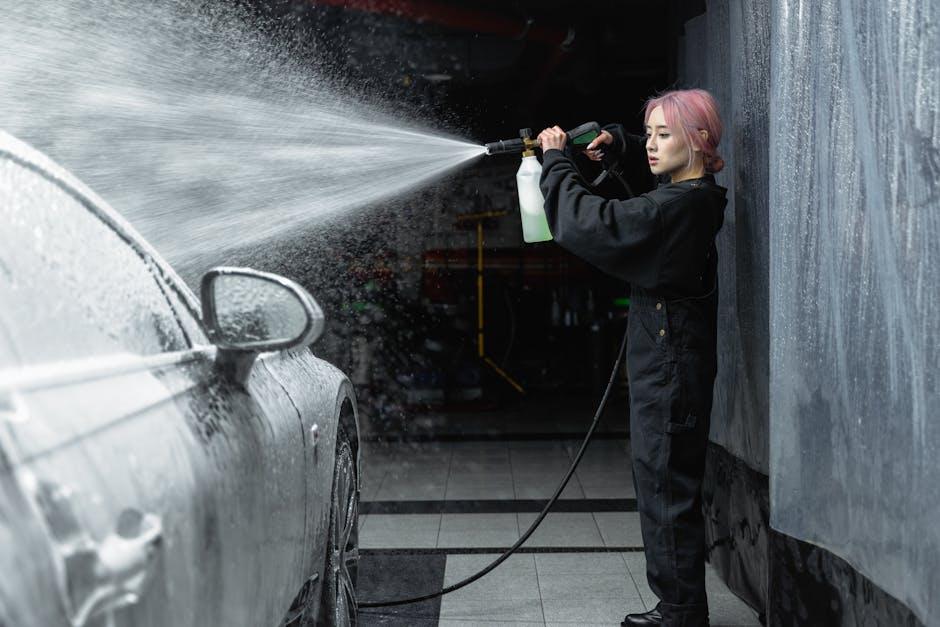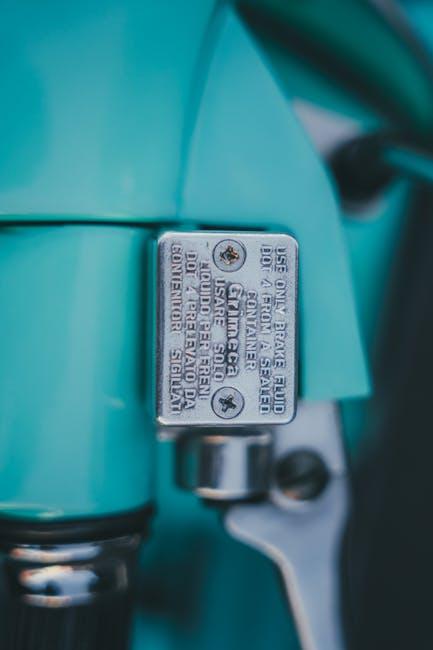There’s a moment every driver dreads: pressing the brake pedal only to feel it sink deeper, the car’s slowing power fading just when you need it most. This unsettling phenomenon, known as brake fade, can turn a routine stop into a heart-pounding challenge. Understanding how brake fade occurs and, more importantly, how to avoid it, is essential for safe and confident driving. In this article, we’ll explore practical strategies to keep your brakes responsive and reliable, no matter the road or the conditions.
Table of Contents
- Understanding the Causes of Brake Fade and Its Impact on Safety
- Choosing the Right Brake Pads for Optimal Heat Resistance
- The Role of Brake Fluid in Maintaining Consistent Braking Performance
- Proper Brake System Maintenance to Prevent Overheating
- Driving Techniques That Minimize Brake Wear and Fade
- Upgrading Brake Components for Enhanced Heat Dissipation
- Q&A
- The Conclusion

Understanding the Causes of Brake Fade and Its Impact on Safety
Brake fade occurs when the braking system’s ability to generate friction diminishes, typically due to excessive heat buildup during extended or intense braking. This heat causes the brake components, especially the pads and discs, to lose their effectiveness temporarily. The most common causes include driving down long, steep hills, frequent hard braking, and using worn-out brake parts. When these conditions overlap, the brakes can overheat, leading to a spongy pedal feel and longer stopping distances, which directly impacts vehicle control and safety.
Understanding the following factors can help in recognizing and preventing brake fade:
- Heat accumulation: Continuous friction raises temperatures beyond optimal ranges.
- Brake fluid boiling: Excess heat can vaporize brake fluid, reducing hydraulic pressure.
- Worn brake pads: Reduced friction material results in less heat absorption.
- Improper driving habits: Riding the brakes or heavy use under load increases fade risk.
| Cause | Impact | Prevention Tip |
|---|---|---|
| Excessive Heat | Reduced friction & brake efficiency | Use engine braking on declines |
| Boiling Brake Fluid | Spongy pedal, delayed response | Regular fluid replacement |
| Worn Pads | Longer stopping distances | Routine brake inspection |

Choosing the Right Brake Pads for Optimal Heat Resistance
When it comes to maximizing heat resistance in your braking system, material composition is king. Brake pads made from ceramic or carbon-ceramic compounds offer superior heat dissipation compared to traditional organic pads. These materials not only maintain structural integrity under extreme temperatures but also generate less brake dust, extending the lifespan of both the pads and rotors. For drivers who frequently encounter steep descents or spirited driving conditions, investing in higher-grade pads designed for elevated thermal tolerance can prevent performance loss during critical moments.
Choosing brake pads with the appropriate heat resistance involves considering your driving habits and vehicle type. Here are key factors to keep in mind:
- Heat Threshold Ratings: Look for pads with manufacturer-specified maximum operating temperatures to ensure they match your usage.
- Friction Stability: Select materials that maintain consistent friction levels even when hot, avoiding sudden drops in braking power.
- Compatibility: Make sure the pads are compatible with your vehicle’s brake rotor material to prevent uneven wear or thermal stress.
| Brake Pad Material | Typical Max Temp (°C) | Heat Dissipation | Ideal For |
|---|---|---|---|
| Organic | 300 | Low | Daily driving, light braking |
| Semi-Metallic | 600 | Moderate | Performance street, mixed use |
| Ceramic | 900 | High | High-performance, long descents |
| Carbon-Ceramic | 1200+ | Exceptional | Track, racing, aggressive driving |

The Role of Brake Fluid in Maintaining Consistent Braking Performance
Brake fluid is the unsung hero in your vehicle’s braking system, playing a pivotal role in delivering consistent and reliable stopping power. This specialized hydraulic fluid transmits the force from your brake pedal directly to the brake components, ensuring that each press results in an immediate and effective response. However, brake fluid is hygroscopic, meaning it absorbs moisture over time. This moisture lowers its boiling point, increasing the risk of vapor lock during intense braking situations, which can lead to brake fade—a dangerous loss of braking efficiency.
Maintaining your brake fluid’s quality is essential for preserving optimal performance. Here are some key practices to avoid brake fade due to compromised fluid:
- Regularly check and replace brake fluid according to the manufacturer’s schedule.
- Use the recommended brake fluid type to ensure compatibility and maximum effectiveness.
- Inspect brake lines and reservoirs for contamination or leaks that could introduce moisture.
| Brake Fluid Type | Boiling Point (Dry/ Wet) | Ideal Use |
|---|---|---|
| DOT 3 | 205°C / 140°C | Daily driving, light braking |
| DOT 4 | 230°C / 155°C | Performance vehicles, heavier braking |
| DOT 5.1 | 270°C / 180°C | Racing, high-performance braking |
By understanding and managing brake fluid properties, you drastically reduce the risk of heat-induced brake fade, keeping your braking crisp and consistent under all conditions.

Proper Brake System Maintenance to Prevent Overheating
Maintaining your brake system in top condition is crucial to prevent excessive heat buildup that can compromise braking performance. Regular inspection of brake pads and rotors allows you to catch wear before it leads to overheating. Ensuring proper brake fluid levels and quality also plays a vital role, as degraded fluid can reduce heat dissipation and cause a spongy brake pedal. For best results, schedule brake checks at least twice a year or more frequently if you tackle steep terrains or engage in heavy towing.
Beyond routine inspections, adhering to these maintenance tips will enhance your brake system’s heat resilience:
- Replace worn brake pads promptly to avoid metal-on-metal contact that generates excessive friction and heat.
- Flush brake fluid periodically to maintain optimal boiling points and prevent vapor lock.
- Keep rotors clean and avoid glazing by not riding the brakes continuously.
- Check caliper function to ensure even pad pressure and avoid hotspots.
| Maintenance Task | Ideal Frequency | Benefit |
|---|---|---|
| Brake Pad Inspection | Every 6,000 miles | Prevents pad failure and overheating |
| Brake Fluid Replacement | Every 2 years | Maintains fluid integrity and performance |
| Rotor Cleaning | During each pad change | Prevents heat spots & uneven wear |

Driving Techniques That Minimize Brake Wear and Fade
Mastering subtle braking techniques can significantly extend the lifespan of your vehicle’s brake components while maintaining optimal performance. One effective approach is to anticipate stops and reduce speed gradually rather than relying on sudden, aggressive brakes. This technique, often called progressive braking, allows the brake system to remain cooler by distributing heat evenly and avoiding sharp temperature spikes that cause fade. Additionally, using engine braking—shifting to a lower gear to slow down the vehicle naturally—helps to reduce the load on your brakes, particularly when descending hills or coming to a stop from higher speeds.
Incorporating a smooth and consistent driving style is equally crucial. Avoid riding the brakes continuously; instead, use brief, firm applications followed by periods of brake release to allow cooling. When driving in hilly or mountainous terrain, consider the following driving tips:
- Plan your route: Use routes that have moderate gradients to minimize brake stress.
- Maintain adequate following distance: This provides enough room for gradual slowing without excessive brake use.
- Avoid overloading your vehicle: Excess weight increases braking demand.
| Driving Condition | Recommended Technique |
|---|---|
| Downhill driving | Use engine braking with intermittent brake taps |
| City traffic | Maintain smooth, steady speed and anticipate stops |
| Heavy load | Increase following distance; avoid sudden stops |

Upgrading Brake Components for Enhanced Heat Dissipation
When pushing your vehicle to the limits, managing brake temperatures becomes vital. One of the most effective upgrades involves swapping out standard brake pads and rotors for high-performance versions engineered to dissipate heat more efficiently. Materials like carbon-ceramic or slotted rotors allow air to flow freely and cool the braking surface quicker, preventing the dangerous buildup of excessive heat. Additionally, performance brake pads made from compounds designed to withstand higher temperatures will maintain optimal friction without glazing or fading under stress.
Consider integrating these components for maximum thermal management:
- Ventilated Rotors: Enhanced channels allow better air circulation.
- Slotted or Drilled Rotors: Help expel gases and heat generated during braking.
- High-Performance Brake Pads: Maintain consistent pad material grip even under intense heat.
- Braided Steel Brake Lines: Reduce fluid expansion and improve pedal feel during heavy braking.
| Component | Heat Dissipation Benefit | Durability |
|---|---|---|
| Carbon-Ceramic Rotors | Exceptional heat resistance | Very High |
| Slotted Rotors | Improved gas expulsion | High |
| Performance Brake Pads | Stable friction at high heat | Medium-High |
| Braided Steel Lines | Consistent pressure and control | High |
Q&A
Q: What exactly is brake fade, and why should I care about it?
A: Brake fade is the gradual loss of braking power that happens when your brakes get too hot. Imagine trying to stop a sprinting cheetah with a tired leash—brakes become less responsive, which can be dangerous, especially on long downhill drives or spirited mountain rides.
Q: What causes brake fade in the first place?
A: The main culprit is heat. When you brake repeatedly or for a long time, friction generates heat. If your brake system can’t dissipate it quickly enough, the pads and rotors overheat, reducing their grip and effectiveness. Overheated brake fluid can also boil, creating gas bubbles that compress under pressure, leading to a spongy pedal feel.
Q: How can I avoid brake fade during everyday driving?
A: Easy does it! Avoid riding the brakes—release them when you can and use engine braking by downshifting if you’re driving a manual or in a mode that supports it on an automatic. This helps slow your vehicle without wearing out your brakes.
Q: What about when driving in hilly or mountainous terrain?
A: Downshifting becomes your best friend. Use your gears to control your speed rather than relying solely on the brakes. Also, plan ahead—break your descent into manageable sections and give your brakes a chance to cool periodically by letting off the pedal.
Q: Are there any maintenance tips to keep my brakes in top shape and resistant to fade?
A: Regularly check and replace brake fluid, since old fluid absorbs moisture and boils easier. Inspect your pads and rotors for wear and overheating signs and upgrade to high-temperature rotor and pad materials if you frequently encounter heavy braking situations.
Q: Can driving style really impact brake fade, or is it mainly about the equipment?
A: Driving style is just as important as the gear. Aggressive, frequent braking generates more heat. Smooth, deliberate braking not only helps avoid fade but also prolongs your brake system’s life.
Q: Is there any tech that helps prevent brake fade?
A: Some vehicles come equipped with ventilated rotors, better cooling ducts, or electronic aids like ABS and brake assist which optimize braking pressure. In motorsports and heavy-duty vehicles, carbon-ceramic brakes and advanced cooling systems push fade far off the map—though these are pricey upgrades.
Q: What should I do if I feel brake fade coming on?
A: Safety first—ease off the brake pedal, downshift if possible, and pull over if you need to let the brakes cool. Avoid panic braking, and if necessary, use your emergency brake cautiously to slow down without overheating your main brake system further.
By understanding brake fade and using these tips, you’ll keep your braking strong, safe, and reliable—no matter the road ahead.
The Conclusion
In the end, mastering the art of avoiding brake fade is less about drastic measures and more about thoughtful care. By understanding your vehicle’s braking system, maintaining it regularly, and adjusting your driving habits, you ensure that your brakes remain responsive when you need them most. Remember, a reliable set of brakes isn’t just a mechanical necessity—it’s your silent partner in safety, ready to perform without fail every time you press the pedal. Keep these insights in mind, and let every stop be as confident as your journey ahead.


2 Comments
h53u9j
h53u9j